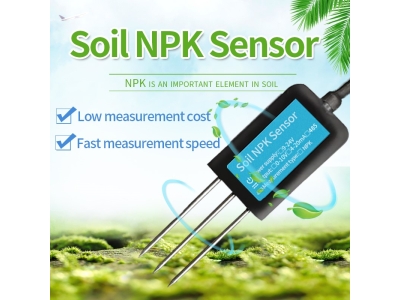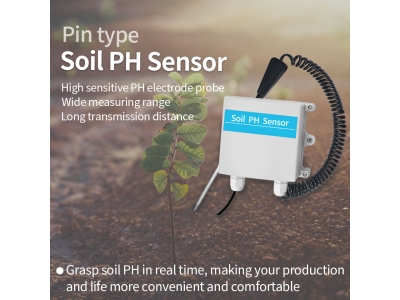In recent years, the agricultural industry has been undergoing a significant transformation driven by technological advancements. One of the most impactful innovations in modern agriculture is the development and integration of soil sensor systems. These advanced technologies have revolutionized the way farmers monitor and manage their crops, leading to improved productivity, resource efficiency, and environmental sustainability. This article explores the profound impact of soil sensor systems on modern agriculture, highlighting their role in empowering farmers to make informed decisions and optimize their farming practices.
The Evolution of Soil Sensor Systems

Traditionally, farmers have relied on manual observation and experience to assess soil conditions and make decisions regarding irrigation, fertilization, and crop management. However, this approach is often limited by subjectivity and the inability to capture real-time data across large agricultural areas. The emergence of soil sensor systems has transformed this paradigm by providing farmers with precise, continuous, and actionable insights into soil moisture levels, nutrient content, temperature, and other critical parameters.
Soil sensor systems encompass a range of technologies, including ground-based sensors, satellite imagery, drones, and IoT (Internet of Things) devices. These tools leverage various sensing mechanisms, such as capacitance, time-domain reflectometry, and electromagnetic induction, to measure and analyze soil properties. By integrating these technologies with data analytics and visualization platforms, farmers can gain a comprehensive understanding of their fields and make data-driven decisions to optimize crop growth and resource utilization.
Enhancing Resource Efficiency
One of the primary benefits of soil sensor systems is their ability to enhance resource efficiency in agriculture. By accurately monitoring soil moisture levels, farmers can implement precision irrigation strategies that deliver the right amount of water to crops based on their actual needs. This targeted approach not only conserves water resources but also mitigates the risk of over-irrigation, which can lead to waterlogging and nutrient leaching.
Furthermore, soil sensor systems enable farmers to optimize their use of fertilizers and agrochemicals. By assessing the nutrient content and pH levels of the soil in real time, farmers can apply fertilizers in a precise and targeted manner, reducing waste and minimizing environmental impact. This not only leads to cost savings for farmers but also contributes to sustainable agricultural practices by minimizing chemical runoff and soil degradation.
Improving Crop Management and Yield Prediction
In addition to resource efficiency, soil sensor systems play a crucial role in improving crop management and yield prediction. By continuously monitoring soil conditions, these technologies provide farmers with valuable insights into the health and development of their crops. For example, real-time data on soil moisture levels can help farmers identify areas of water stress and take proactive measures to address potential crop damage.
Moreover, soil sensor systems contribute to the development of predictive analytics models that enable farmers to forecast crop yields with greater accuracy. By analyzing historical soil data, weather patterns, and crop performance, farmers can make informed decisions regarding planting schedules, harvest timing, and overall crop management strategies. This predictive capability not only facilitates better resource allocation and market planning but also helps farmers mitigate the impact of adverse environmental conditions on their yields.
Enabling Precision Agriculture and Decision Support
The integration of soil sensor systems into modern agriculture has paved the way for the widespread adoption of precision agriculture practices. By combining soil data with GPS technology and advanced machinery, farmers can implement site-specific management strategies that tailor inputs and interventions to the unique characteristics of each field. This targeted approach allows for the optimization of seed planting, crop protection, and harvesting activities, leading to improved overall efficiency and yield outcomes.
Furthermore, soil sensor systems serve as a valuable decision support tool for farmers, providing them with actionable insights and recommendations based on real-time and historical data. Through user-friendly interfaces and mobile applications, farmers can access visualizations of their fields, receive alerts for critical conditions, and receive automated recommendations for irrigation, fertilization, and pest management. This empowers farmers to make timely, informed decisions that maximize the productivity and sustainability of their operations.
Challenges and Future Directions
While soil sensor systems have demonstrated substantial benefits for modern agriculture, their widespread adoption and optimization are not without challenges. One of the primary obstacles is the cost associated with acquiring and implementing these technologies, particularly for small-scale and resource-constrained farmers. Additionally, there is a need for standardized protocols and interoperability among different sensor systems to ensure seamless data integration and compatibility across agricultural platforms.
Looking ahead, the future of soil sensor systems in agriculture holds great promise. Continued advancements in sensor technology, data analytics, and connectivity are expected to further enhance the capabilities and accessibility of these systems. Furthermore, the integration of artificial intelligence and machine learning algorithms will enable more sophisticated data processing and decision-making capabilities, unlocking new opportunities for precision agriculture and sustainable farming practices.
Conclusion
In conclusion, soil sensor systems have emerged as a transformative force in modern agriculture, empowering farmers to make data-driven decisions and optimize their farming practices. By enhancing resource efficiency, improving crop management, enabling precision agriculture, and providing decision support, these technologies have revolutionized the way farmers monitor and manage their fields. As the agricultural industry continues to embrace innovation and technology, soil sensor systems will play an increasingly pivotal role in driving productivity, sustainability, and resilience across farming operations.
In summary, the impact of soil sensor systems on modern agriculture cannot be overstated. From resource efficiency to precision agriculture and decision support, these technologies have reshaped the way farmers interact with their land, enabling them to make informed decisions that drive productivity, sustainability, and environmental stewardship. As we look to the future, the continued advancement and integration of soil sensor systems will undoubtedly play a central role in shaping the next era of agricultural innovation and progress.






